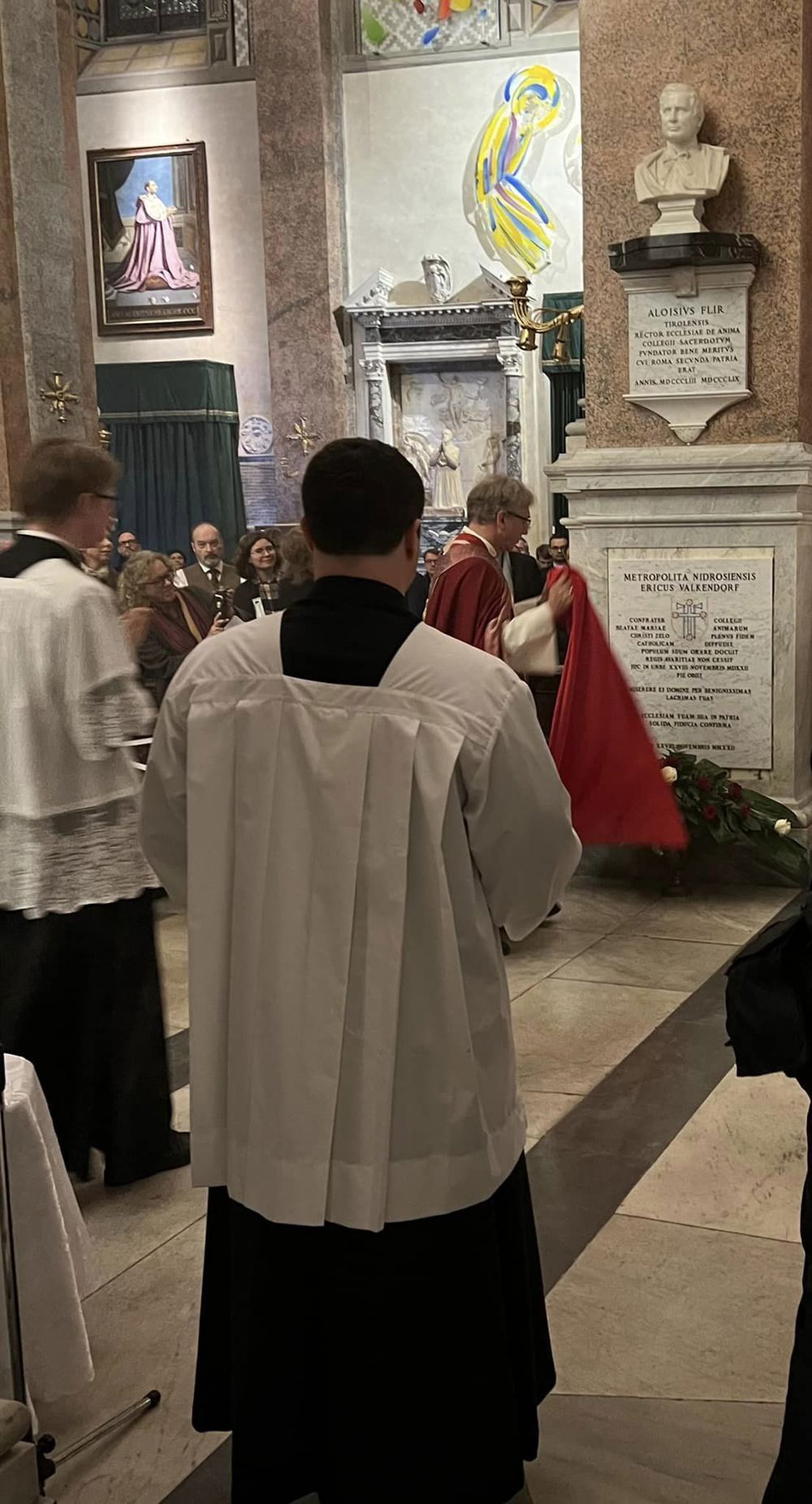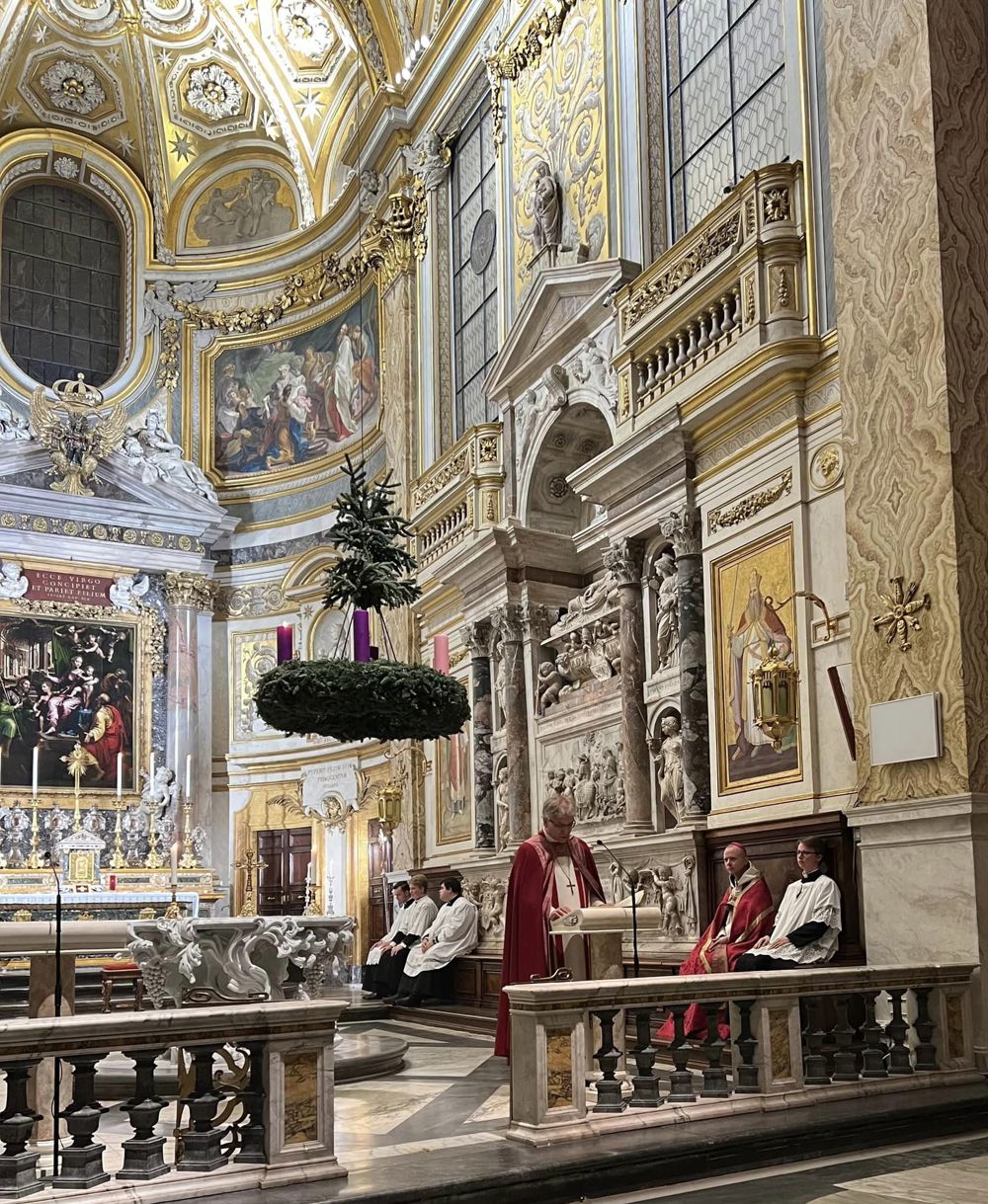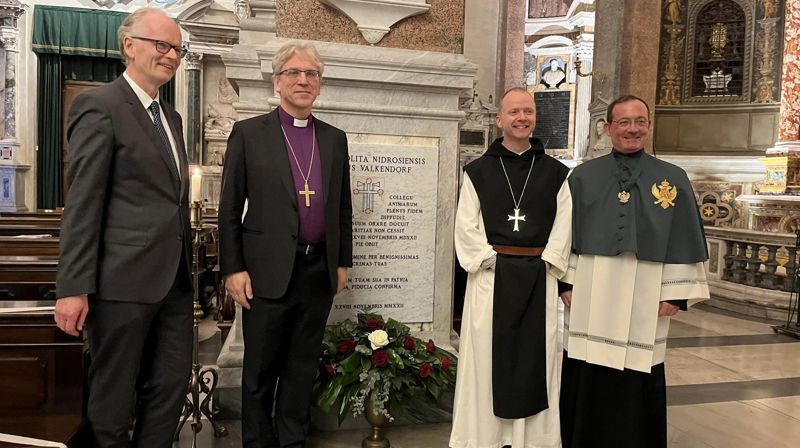Address at the unveiling ceremony of the Memorial Plaque of the late Archbishop Erik Valkendorf, 1465-152 in Santa Maria dell’Anima Church, Rome, November 28, 2022.
Your Excellency Ambassador Vibe,
Bishop Erik, Dean Dr Max,
Friends from Nidaros and Friends of Nidaros,
Sisters and Brothers in Christ,
We gather today in this church to remember and honour the late Erik Valkendorf, who died here in Rome November 28, 1522, 500 years ago, after serving as Archbishop of Nidaros for 12 years.
As we today remember him as one of our predecessors in the ministry of episkopè, we are reminded of the call given by our Lord Jesus Christ to carry on the apostolic ministry and mission in every generation, and in every time, to the ends of the world.
Erik Valkendorf was in his time, on his watch, faithfully filling this episcopal ministry of continuity and renewal. This is manifested through his many new initiatives for keeping, maintaining, organizing, and protecting the local Church in Nidaros – and therefore also in Norway.
Among them is quite emblematic how he in 1519 initiated, financed, and organized the printing of the two liturgical manuals to be used in the entire Archdiocese, Missale Nidrosiense and Breviarium Nidrosiense. These are among the first printed books in Norway.
The initiative to restore and maintain the Octagon around the high altar in the Nidaros Cathedral, is one of the most precious and visible remaining fruits of his leadership and work. This most significant piece of architecture in the Cathedral, and many would say in Norway at large, with something between 20 000 and 30 000 hand carved stones, was probably totally renovated and restored under his leadership. The similarity with the grave of Christ in the Holy Sepulchre in Jerusalem carries the clear message of how the Nidaros Cathedral is a Church of Christ, bringing the fruits of the death and resurrection of Christ to all, also to the church in our province and nation. The Shrine of St Olav at the altar showed how the particular Norwegian church and its life should also be an expression of the call to follow Christ - in life and death.
This call to care for the ministry and mission of Nidaros Archdiocese - in relation to the King and his power and interests - was driving Archbishop Erik Valkendorf to return to this city of Rome. This became his last journey. That part of his story – as well as other parts of it – will be elaborated, illuminated and discussed in a seminar tomorrow.
However, it is a facinating story of how the church and its leadership has to deal with the condition of the world and facing the challenges of the time, from within the church and from other processes and developments. This is the reality in any time.
For many reasons, and particular from a Lutheran perspective, the years of Archbishop Erik Valkendorf’s ministry are particularly interesting, as they to some extent are parallel to the great movements and changes of the first decades of the 16th Century later called the Reformation. Pope Hadrian VI, whom he was waiting to see here in Rome, tried in his short ministry to address some of the critique raised against the curia of the time. Some have compared some of his initiatives to simplify the life of the church leadership with statements of the present Pope Francis. Maybe Archbishop Erik and Pope Hadrian could have found some othet ways of reorganizing the relationship between the King and the Church in Norway that could have also later brought another relationship between the two institutions than those we got in our country?
We are in these days reminded how the churches should contribute not only to care for its own power but also to address the urgent challenges and opportunities of our time, even when we are not able to find the solutions immediately. The need for proper relations between religion and power, built on a common basis of justice and peace, is so urgent in many parts of the world. We are scared these days by the mutual misuse of a relationship between religion and state, church and power, as it is spelled out before our eyes in the support of the Russian church to the brutal war against the people of Ukraine. We do see all over the world how urgent it is that the Universal Declarations of Human Rights are promoted as an obligation of every state and a commitment of the churches based on our common Christian heritage.
What we do know, is that the events of the 16th Century caused divisions between us and the establishment of national state churches. In the memory of our common predecessor, we should use this moment to recommit ourselves and our churches to promote our common calling to share a united witness to Christ in our time.
The ecumenical dialogues of the last Century have improved the relations between our churches in a significant and sustainable way. They have brought us new insight in what we have in common as churches, Lutherans and Roman Catholics. They have also brought us many steps “From conflict to communion”, as the title of an official document from the dialogues between the Pontificial Council for Promoting Christian Unity (PCPCU) and the Lutheran World federation (LWF) says.
The Anglican-Lutheran dialogue has illuminated parts of the story of Erik Valkendorf and what happened after him. Particularly in the Porvoo Common Statement of 1996, the continuity of the episcopè (e.g. in Nidaros) has been recognized both in terms of the continuity of the episcopal sees and the cathedrals, and most of all in the continuity in the sharing the Apostolic faith. This has a potential, in my view, also in our Catholic-Lutheran dialogues, and we try to make it visible in Nidaros in Cathedral our time.
In the Catholic-Lutheran dialogues the examination of the history of the Reformation and its consequences has led to a new and common understanding. The mutual doctrinal condemnations related to the doctrine of justification of that period are not adequate and relevant for our relationships today.
The visit of Pope John Paul II to Nidaros in 1989 opened up for new relations between us. The pilgrimage visit of Pope Francis to Lund and the Lutheran World Federation in 2016, and to Geneva and the World Council of Churches in Geneva in 2018, are recent signs of affirmation of these relationships.
The event we share today is an expression of the same commitment: to share and acknowledge what we have together, even as our churches are separated. It is also a sign of our commitment to walk, work and pray together, both in the episcopal ministries to which we are appointed, and in the initiatives we can take together - like today.
Therefore, I warmly thank those who have taken the initiative to pursue and fulfil the idea of marking the work and life of the late Archbishop Erik Valkendorf, and your tireless efforts until today, under the leadership of Professor Rolf Grankvist. I thank the host here in the church, Dean Dr Max. The Diocesean council of Nidaros gave the financial support to the plaque we now see here in this church. And I thank my colleague bishop Erik for your efforts to organize this event.
As we both were consecrated to our ministry as bishops in our respective churches in the Octagon of Nidaros Catherdal, we are sharing our gratitude for Archbishop Eriks efforts to restore and renew it - as it remains a constant sign to both of us of our shared faith in the risen Christ.
As we mark this day of the death of Archbishop Erik Valkendorff, we are also reminded that he is not only a predecessor in ministry, but also part of the cloud of witnesses of faith. At moments like this, we are invited to be inspired by them and their faith, hope and love – for the Church and for this wounded and vulnerable world.
May the Triune God continue to bless the memory of Erik Valkendorf.




